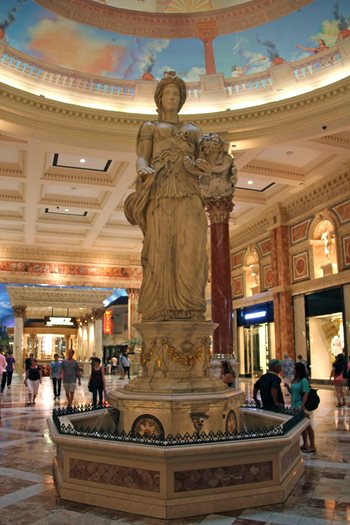Rome's legacy in Las Vegas, Nevada- Caesars Palace
Posted on Sep 18, 2012 in category
The city of ancient Rome from the late 1st century B.C. and particularly during the early principate era in the 1st century A.D., experienced a "cultural revolution" highlighted by "frenetic cultural activity" (G.Woolf 2001) such as the construction of monumental architecture including impressive fora for government and commercial business, theatres for pleasure or 'otia' and large bathhouses for the public. The inclusion of Greece in its expanding empire (86 B.C.) led to a frenzy of collecting Greek sculpture by elite Romans. Arguably, the rich Roman elite were transferring their competitive political ambition, now checked by Augustus and his successors, to enhancing their houses and villas with eastern Mediterranean peristyle gardens that boasted elaborately adorned Greek original or replica statues. In this way Romans also experienced a 'consumer revolution' with Rome's population of 1 million acting like a sponge on its ever-expanding empire. Both the variety and quantity of consumer goods increased dramatically in order to satisfy a more discerning and status-driven society. Archaeological evidence throughout the empire has shown this trend occurred especially at the beginning of the 1st century A.D. under the Julio-Claudians (G. Woolf , Becoming Roman - the Origins of Provincial Civilisation in Gaul, Cambridge 2003).
Some things never change and 'Sin City' or Las Vegas definitely has strong parallels with Rome. This mecca for leisure-lovers is also designed to encourage visitors to wildly consume the city's gambling, shopping, dining and theatrical facilities. A potpourri of international influences are starkly evident in the monumental architectural designs and themes or 'architainment' (Blair Kumin) of the Las Vegas casinos that stretch out along the pulsating 'Strip': the Paris Casino with its domineering look-alike Eiffel Tower, the Venetian Casino with its mock canals and small flotilla of gondollas mostly sitting idle in the intense heat and, of course, Rome's gift to the Nevada Desert, Caesars Palace (the apostrophe of possession was never included!).


Paris' 'Arc de Triomphe' was built in 1806 by Napoleon to commemorate his victory at Austerlitz. Napoleon was a fan of the classical Graeco-Roman tradition. He used the triumphal arch in the same manner of victorious Roman generals namely to boast about his victory over a larger Russo-Austrian army. This triumphal arch outside the Paris Casino advertises another conquering personality cult - the celeb chef, Gordon Ramsay, in a style one could call 'kitchen kitsch'!!
Caesars Palace opened in 1966 at a cost between $US19-24 million, money that was borrowed surreptiously from the Teamsters Union Central State Pension Fund. In an audacious attempt to mimick ancient Rome, Jay Sarno used Graeco-Roman statuary to the max. He wished to indulge all of his customers making each person feel like a Caesar! Sarno was extending the Hollywood image of Rome by this display of opulence and by inference, inviting consumers to participate in decadent experiences in order to gain wealth, fulfilment of desires and of course, power. (M. Malahud, "As the Romans Did? Theming Ancient Rome in Contemporary Las Vegas").

A replica of 'Augustus of Prima Porta' stands omnipotently over the Strip. The original was found in Livia's garden villa 14.5 kilometres from Rome and is now in the Vatican Museum. Possibly commissioned by Tiberius in A.D.15 shortly after Augustus' death, the statue has carved on its cuirass a tribute to his late father's victory over the Parthians .
'Augustus of Prima Porta' at the Vatican Museum

The original 'Winged Victory of Samothrace' was also set in a small pool within a rock niche on the island of Samothrace although it was prominently positioned on the prow of a warship. A gift from Rhodes, the 'Winged Victory' or 'Nike' commemorated a naval victory.
The Louvre in Paris is now the custodian of the 'Winged Victory of Samothrace'.

'Apollo Belvedere' strikes a classic contrapposto pose (combined frontal and profile views). The ancient Greek original was probably a bronze by Leochares circa. 330 B.C. with the Romans copying it in marble circa. A.D. 130-140. It stood over two metres in height. The original Roman statue is displayed in the Belvedere Courtyard of the Museo Pio-Clementino (Vatican Museum) whilst Caesars Palace has its copy within its foyer's fountain .
The more recently built Forum Shops complex in the 1990's has extraordinary reproductions some call "archaeological correctness" (Alan Hess) including frescoes from Pompeii, grill work and lamps copied from antiquity as well as two storey buildings with pastel/earth colours. Caesars Palace owners offer visitors in the Forum Shops a luscious taste of life in ancient Rome but with a difference, they want it to be better!! Another point of view sees the Forum Shops as a type of social yearning for the old traditional values:
"Roman references confer status and tradition on commodities, and they offer a consumer oriented ideal in an idiom of Roman luxury....Part of the appeal of the Forum Shops is that it evokes a vanished urban world of wealth, power, privilege and civic order."
- (M. Malamud, Ibid. in Arion: Journal of Humanities and the Classics, vol.6 no 2 1998, p.21)

The goddess Fortunna who is holding the cornucopia of plenty. Can this Roman image help legitimise self-gratification under the guise of good luck? A very 1990's phenomenon!!

'The Colosseum' seats over 4,000 people for concerts. A fake Egyptian obelisk stands outside as well as marble porticos with mock Corinthian columns.
Caesars Palace may be an academic chuckle but it is also a window into American values, aspirations and shortcomings in each of its building phases. What will the next phase hold??